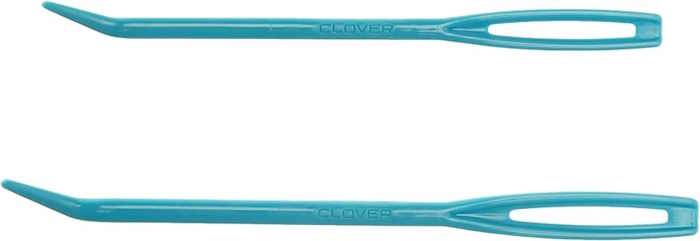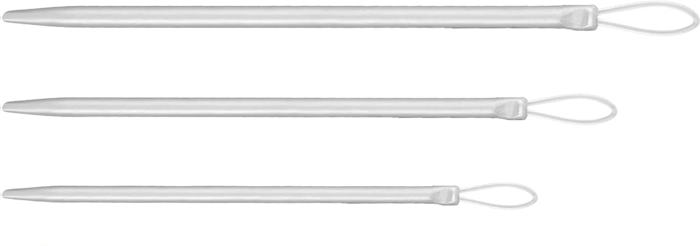- Home
- Jumbo Yarn
Jumbo Yarn: A Guide for Beginners to Advanced Crafters
Jumbo yarn, also known as super bulky or roving yarn, is a thick, luxurious yarn that has gained popularity among knitters and crocheters.
This yarn is perfect for creating cozy, oversized projects in a fraction of the time it would take with thinner yarns. Whether you're a beginner or an advanced crafter, working with jumbo yarn can be both rewarding and challenging.
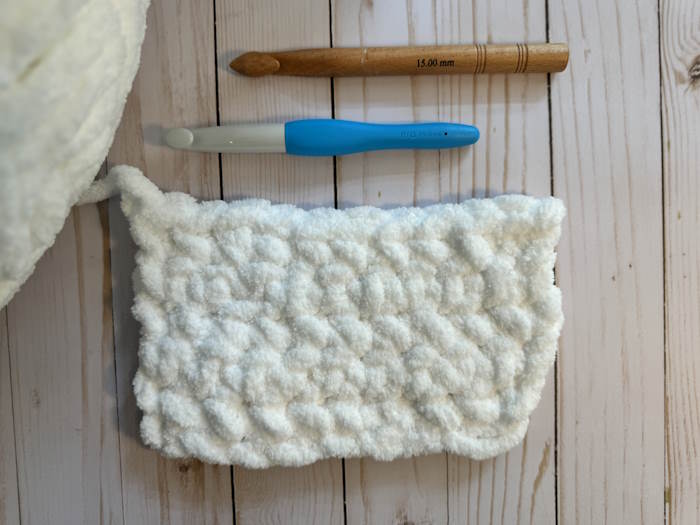
What is Jumbo Yarn?
Jumbo yarn is thicker than bulky-weight yarn. It typically has a gauge of 1-3 stitches per inch on US size 11 (8mm) needles or larger. Jumbo yarn can be made from various materials, including wool, acrylic, polyester, and cotton, and is often soft and lofty.
What Can You Make with Jumbo Yarn?
The possibilities are endless when it comes to creating with jumbo yarn. Some popular projects include:
1. Blankets and throws
2. Scarves and cowls
3. Hats and headbands
4. Pillows and cushions, poufs
5. Wall hangings and rugs, baskets
6. Sweaters and cardigans
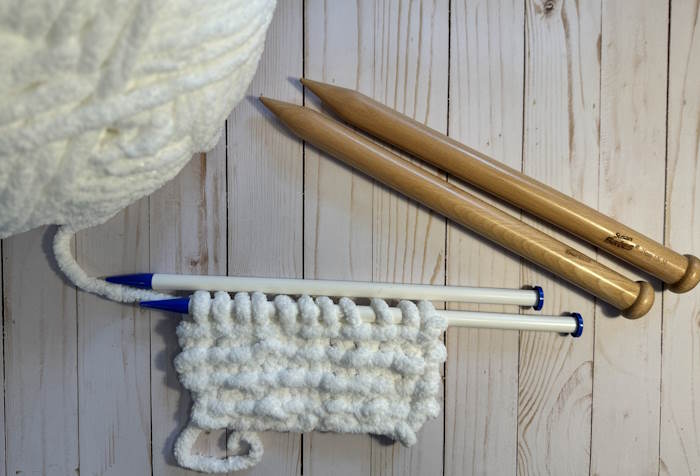
Tools, Gauge, Needle Size, and Hook Size for Jumbo Yarn:
 As you can see by this chart by Lion Brand Yarns, you will need quite a bit of yarn to make the objects of your choice.
As you can see by this chart by Lion Brand Yarns, you will need quite a bit of yarn to make the objects of your choice.Needles and Hooks
Knitting Needle Size: US size 11 (8mm) or larger, depending on the specific yarn and desired fabric density.
Crochet Hook Size: US size Q (15mm) or larger, depending on the specific yarn and desired fabric density.
Guage Recomendations
Each yarn brand will indicate the typical gauge recommendations on their yarn labels. The Craft Yarn Council also provides some guidelines. Here is an example:
Knitting: 5 sts x 7 rows = 4" (10 cm) in stockinette st.
Crochet: 4 sts x 4 rows = 4" (10 cm) in single crochet st.
If you are following a pattern, check the gauge provided by the designer.
Additional Tools Needed
You will also need a pair of scissors, some stitch markers and a tapestry needle.
Typical tapestry needles will not work with Jumbo yarn. You will need one with a very large eye or a substitute.
Or, if you do not have these tools, consider a small crochet hook say an F (3.75 mm) or G6 (4.0 mm) for weaving in ends.
Pros of Using Jumbo Yarn:
- Quick projects: Because the yarn is thick, projects work up much faster than with thinner yarns.
- Instant gratification: Seeing your project grow quickly motivates and satisfies you.
- Beginner-friendly: Jumbo yarn is easier for beginners to work with because it's easier to see individual stitches.
- Cozy and warm: Projects made with jumbo yarn are often incredibly cozy and warm, perfect for chilly weather.
Cons of Using Jumbo Yarn:
- Expensive: Jumbo yarn tends to be more expensive than thinner yarn due to the material used.
- Heavy: Projects made with jumbo yarn can be pretty heavy, which may not be suitable for some garments or individuals.
- Limited stitch definition: The thickness of the yarn can make intricate stitch patterns less visible.
- Storage space: Jumbo yarn projects can take up a lot of storage space due to their size.
- Hand Washing: Even Jumbo-weight acrylic yarns require hand washing and flat drying. So, if you are planning a big blanket, remember this caveat.
Exciting Ways to Use Jumbo Yarn
If you are undecided about knitting or crocheting with Jumbo yarn, there are some other options to consider.
Use Scraps to Embellish Ready-made Products
Use a small amount of jumbo to embellish a ready-made product such as a tote bag, wall hanging, the back of a jacket, or the front of a pillow. You only need some jumbo yarn, a pencil or chalk, and some fabric glue. Draw your design on your chosen fabric, then glue the yarn.
Arm Knit or Finger Crochet
This is an interesting way to make crochet or knit fabric. If you want to try your hand (I mean your fingers) in this crochet technique, Yarnspirations offers a helpful tutorial.
If you prefer to take up arm knitting, Love Crafts offers astep-by-step instructions.
Popular Brands of Jumbo Yarn
Lion Brand Wool-Ease Thick & Quick
Pros: Soft, lightweight, and easy to care for due to its wool-acrylic blend.
Cons: May shed and pill over time.
Bernat Blanket Big
Pros: Incredibly soft, machine washable, and affordable.
Cons: 100% polyester may not be as warm as natural fibers.
We Are Knitters The Wool
Pros: 100% Peruvian Highland wool, ethically sourced, and offers excellent stitch definition.
Cons: Hand wash only and may feel slightly coarse to some.
Malabrigo Rasta
Pros: Hand-dyed merino wool with stunning color variations and incredible softness.
Cons: Expensive and requires gentle hand washing.
Big Twist Jumbo Polyester Yarn
Lion Brand I like Big Yarn
Pros: Interesting Texture
Cons: Requires Handwashing
Tips for Working with Jumbo Yarn:
- Use appropriate tools: Use large needles or hooks suitable for the yarn's gauge to avoid hand strain and maintain even tension.
- Keep it simple: Opt for simple stitch patterns that showcase the yarn's texture and color rather than intricate designs.
- Swatch first: Always create a gauge swatch to ensure your project will have the correct size and drape.
- Join yarn carefully: When joining new yarn, avoid creating bulky knots that may be visible in the finished project.
- Experiment with different materials: Try working with jumbo yarn in various fibers to discover your preferences and the properties of each material.
Alternatives to Jumbo Yarn
Don’t want to invest in Jumbo Yarn? You may approximate its thickness by knitting or crocheting with two strands of heavy (Aran) worsted-weight yarn.
Make a swatch first to see how it works. This may be an economical way to try jumbo yarn without the price tag.
Side Note: What is Aran Yarn
Let me explain if you’re a little confused about Aran weight yarn (I know I was).
The Craft Yarn Council defines worsted weight yarn as #4 yarn. Aran weight yarn is a worsted weight, number 4 yarn but just a little thicker, but not thick enough to be considered a chunky or #5 yarn.
The most significant difference is that the knitting needle size for worsted weight is often listed as a US 7 (4.5 mm) but a US 8 (5.0 mm) for Aran weight yarn.
The same is true for crochet hooks. A larger hook should be used with Aran weight yarn.
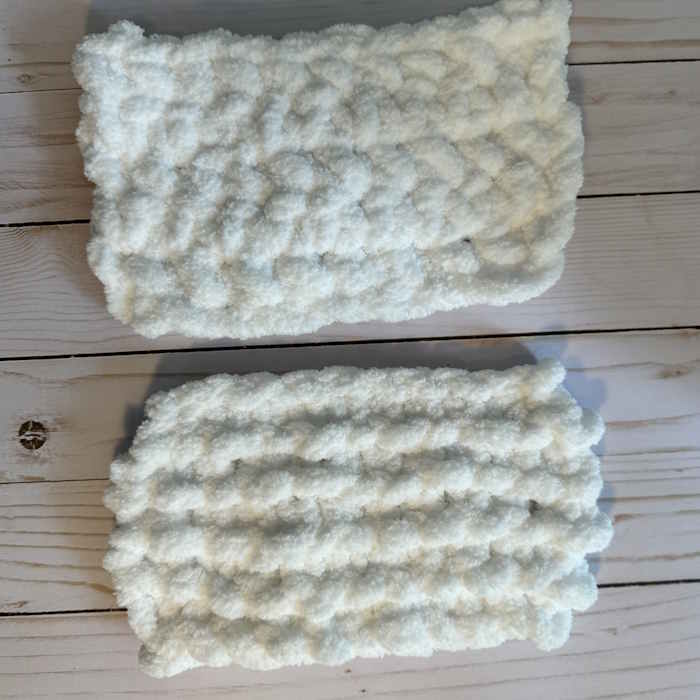 Can you identify which swatch is made on knitting needles and which was crocheted using a large crochet hook?
Can you identify which swatch is made on knitting needles and which was crocheted using a large crochet hook?Spoiler Alert: The top swatch was crocheted and the bottom was knitted.
I Had To Try This For Myself

I'm sure I sound nerdy, but I love to see my stitches, so stitch definition is important to me. The swatch pictures I provided above were pretty, but I really couldn't tell the difference between the swatch made with the knit garter stitch and the crochet swatch worked in single crochet.
So, I tried to mimick Jumbo yarn using a double strand of Worsted weight #4 Aran yarn. I used Lion Brand Fisherman's Wool. I am going to let you be the judge. Don't forget to contact me (below) with your opinions, questions or projects you have made with Jumbo Yarn.
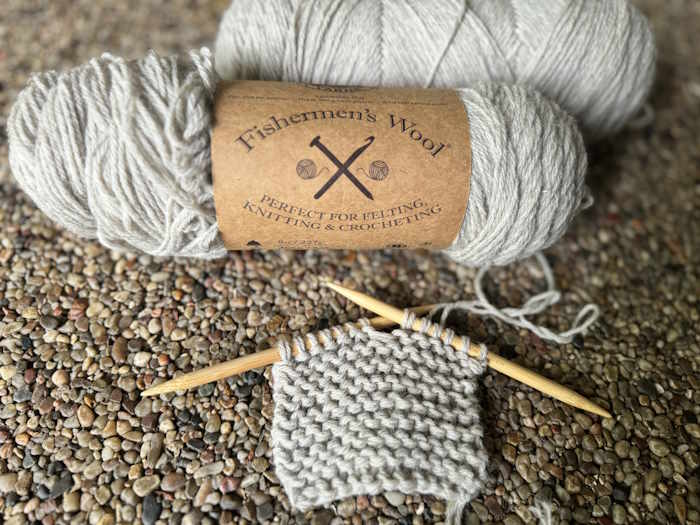
Last Words
In conclusion, jumbo yarn offers many possibilities for knitters and crocheters of all skill levels. While it may have some drawbacks, the benefits of quick, cozy projects and the satisfaction of working with this luxurious yarn make it a worthwhile addition to any crafter's stash.
By keeping the tips and considerations in mind, you'll be well on your way to creating beautiful, oversized projects with jumbo yarn. Ready to try Jumbo Yarn? Grab your hook or needles and let's get busy.
Janice
About Janice
Hi, I’m Janice, the voice behind Smart-Knit-Crocheting. I love to knit and crochet and even more, I love teaching others what I know.
Though I learned to knit and crochet as a child, I didn’t get serious about these amazing hobbies until I retired. I’m a certified knit and crochet instructor through the Craft Yarn Council and am working on becoming a Master Hand Knitter through The Knitting Guild Association.
I’m currently living with my husband of over 50 years and our 6 Shih Tzu dogs.
I love hearing from you, so please drop me a line and let me know what you’re working on, whether you love knitting or crocheting more, and if you have any questions. Please visit my about me page for more information.
Happy Crocheting
